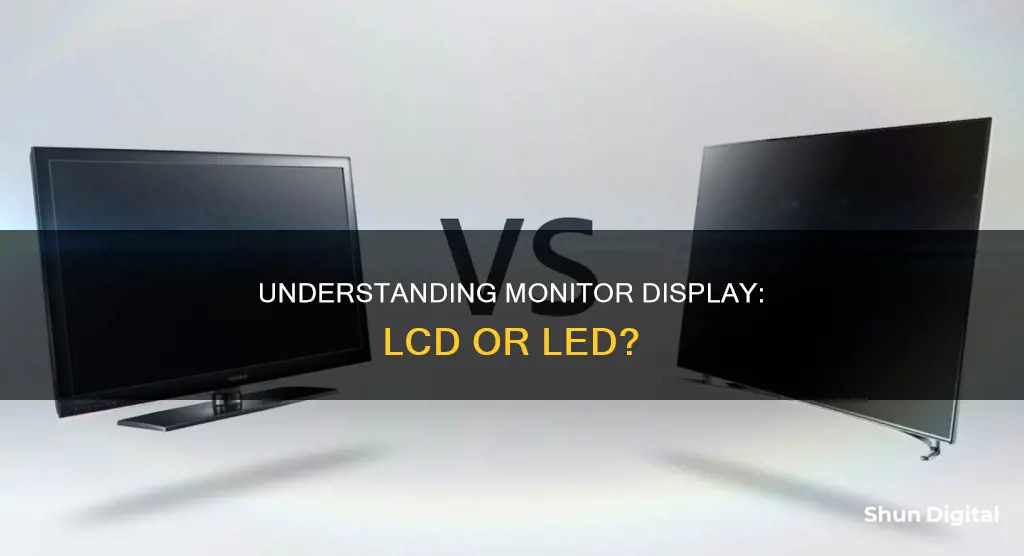
If you're unsure whether your monitor is LCD or LED, it's probably an LED-LCD monitor. All LED screens are LCD screens, but not all LCD screens are LED. LED screens are a subtype of LCD that uses an LED backlight instead of fluorescent. So, if your monitor has LED backlighting, it's an LED-LCD monitor; if it uses fluorescent backlighting, it's an LCD monitor.
What You'll Learn

LCD monitors use cold cathode fluorescent lamps for backlighting
LCD stands for Liquid Crystal Display. All LED monitors are a type of LCD monitor, with the term "LED monitor" being shorthand for "LED-backlit LCD monitor". LCD monitors use cold cathode fluorescent lamps (CCFLs) for backlighting, while LED monitors use light-emitting diodes.
LCD monitors use cold cathode fluorescent lamps (CCFLs) for backlighting. CCFLs are long, thin tubes that produce light through the interaction of electricity with mercury vapour inside the tube. They are known for their long lifespan, high brightness, and low power consumption. CCFL backlights are widely used in LCD monitors and televisions because they can illuminate the entire screen evenly, ensuring clear and vibrant images.
The light produced by CCFLs is white, but filters can be used to achieve different colours. CCFL technology offers a bright and even backlighting solution for LCD displays, resulting in sharp images. Additionally, CCFLs have a long lifespan and consume less power compared to other lighting technologies.
However, CCFL backlights have some limitations. They contain mercury, which can be harmful to the environment if not disposed of properly. CCFL backlights also have a shorter lifespan than LED backlights and require higher voltages to operate.
In recent years, LED backlights have become more common due to their improved energy efficiency, longer lifespan, and better colour reproduction. LED backlights are also more easily dimmable, allowing for improved contrast ratios.
While LED technology has become the standard for backlighting in most electronic devices, CCFL backlights are still used in some niche applications, such as certain medical devices, industrial equipment, and legacy displays.
Easy Guide to Installing ASUS Monitor Driver
You may want to see also

LED monitors use light-emitting diodes for backlighting
LED monitors use light-emitting diodes (LEDs) for backlighting, as opposed to the cold cathode fluorescent lamps (CCFLs) used in LCD monitors. This makes LED monitors a subtype of LCD monitors, as they still use liquid crystal displays but with LED backlighting.
LED backlighting offers several advantages over traditional fluorescent backlights. Firstly, LEDs are more energy-efficient, consuming significantly less power than other types of backlights. This makes them a popular choice for energy-hungry devices and can result in lower power consumption and reduced electricity bills over time. Additionally, LED backlights are available in small sizes, with LEDs being as small as 2 mm, allowing manufacturers to create smaller devices with slimmer profiles.
LED backlights also offer increased lifespan compared to traditional CCFL backlights. While CCFL backlights in LCDs last around 30,000 to 60,000 hours, LED backlights typically last 50,000 to 100,000 hours, with some reports claiming up to 50,000 hours of continuous use. This longer lifespan is due to the more durable nature of LED backlighting technology.
Another benefit of LED backlights is their low heat production. LEDs produce significantly less heat than other types of backlights, lowering the risk of fire. This makes them safer to use and helps to prolong the lifespan of the device.
In terms of performance, LED monitors offer superior picture quality with better contrast ratios and colour accuracy compared to LCD displays. LED monitors, especially those with full-array backlighting, can display deeper blacks and offer improved visual clarity. Additionally, LED monitors often have faster response times, reducing motion blur and ghosting, making them a better choice for gaming and graphic design.
In summary, LED monitors use light-emitting diodes for backlighting, offering improved energy efficiency, longer lifespan, safer operation, and superior picture quality compared to traditional LCD monitors with CCFL backlights.
Unlocking GPU Usage Monitoring: A Unified Approach
You may want to see also

All LED monitors are a type of LCD monitor
When shopping for a new monitor, you will often come across the terms LCD and LED. But what is the difference between the two?
LCD stands for Liquid Crystal Display. This technology uses liquid crystals, which are substances with properties of both liquids and solids, to create images on a screen. When an electric current is applied, the liquid crystals align to either allow or block light, thus creating the images you see on the display. LCD monitors use cold cathode fluorescent lamps (CCFLs) for backlighting.
LED, on the other hand, stands for Light-Emitting Diode. LED monitors use light-emitting diodes for backlighting instead of traditional fluorescent lights. LED monitors are a type of LCD monitor, with the term "LED monitor" being shorthand for "LED-backlit LCD monitor". In other words, all LED monitors are LCD monitors, but not all LCD monitors are LEDs.
The difference between the two lies in their backlighting technology. LCD monitors, as mentioned earlier, use CCFLs for backlighting, while LED monitors use light-emitting diodes. LED monitors offer superior picture quality with better contrast ratios and deeper blacks compared to LCD displays. They are also more energy-efficient, resulting in lower power consumption and reduced electricity bills. Additionally, LED monitors have a longer lifespan than traditional LCD monitors due to their more durable backlighting technology.
When it comes to gaming, LED LCD monitors are generally preferred over CCFL LCD monitors. However, for competitive FPS gaming, a LED LCD monitor with a TN panel is recommended due to its faster response times. On the other hand, LCD monitors are more affordable, making them a good choice for budget-conscious buyers. They also have more uniform backlighting and emit less blue light, which can help reduce eye strain.
In summary, while both LCD and LED monitors have their advantages, it is important to consider your specific needs when making a purchase decision. For gaming, graphic design, or video editing, an LED monitor with full-array backlighting is often preferred due to its superior picture quality and color accuracy. If energy efficiency and a longer lifespan are priorities, LED monitors are the way to go. However, if budget is a concern, LCD monitors offer good value and performance.
Choosing the Right Screw Size for Red Monitors
You may want to see also

LED monitors are thinner, lighter, and use less power than CCFL LCD monitors
When it comes to choosing a monitor, it's important to understand the differences between LCD and LED technologies. All LED monitors are a type of LCD monitor, but not all LCD monitors use LED backlighting. So, what are the advantages of LED monitors over CCFL LCD monitors?
Thinner and Lighter Design
LED monitors are significantly thinner and lighter than CCFL LCD monitors. This is because LED backlighting technology uses small light-emitting diodes (LEDs) that can be placed along the edges of the screen or evenly distributed across the entire screen. CCFL backlighting, on the other hand, uses fluorescent lamps that are thicker and heavier, making the overall monitor bulkier. The thinner and lighter design of LED monitors makes them ideal for slim and portable devices, such as laptops.
Improved Power Efficiency
LED monitors consume less power than CCFL LCD monitors. LEDs require less power to produce the same level of brightness as CCFLs. This lower power consumption leads to reduced electricity costs over time and extended battery life for portable devices. LED monitors are said to be up to 50% more energy-efficient than conventional CCFL monitors. Additionally, LED monitors often have better power management features, allowing for more precise control over screen brightness.
Enhanced Image Quality
LED backlighting can provide brighter and more vibrant colours than CCFL backlighting. The higher brightness of LEDs can even combat glare caused by direct sunlight, ensuring an optimal viewing experience regardless of the environment. LED monitors also offer better colour accuracy and improved visual clarity. The combination of higher brightness, better colour accuracy, and improved clarity results in superior image quality on LED monitors when compared to CCFL LCD monitors.
In summary, LED monitors offer several advantages over CCFL LCD monitors. They are thinner, lighter, and more power-efficient, making them ideal for portable devices. Additionally, the improved backlighting technology of LEDs enhances image quality and provides a more visually pleasing experience for users. While LED monitors may be more expensive upfront, their long-term benefits, including reduced power consumption and improved image quality, make them a popular choice for consumers.
Dumping LCD Monitors in Minneapolis: A Step-by-Step Guide
You may want to see also

LCD monitors are cheaper than LED monitors
When shopping for a new monitor, you will often come across the terms LCD and LED. But what is the difference between the two, and why are LCD monitors generally cheaper than LED monitors?
The Difference Between LCD and LED
The main difference between LCD (Liquid Crystal Display) and LED (Light Emitting Diode) monitors lies in their backlighting technology. LCD monitors use cold cathode fluorescent lamps (CCFLs) for backlighting, while LED monitors use light-emitting diodes. It is important to note that all LED monitors are a type of LCD monitor, and the term "LED monitor" is shorthand for "LED-backlit LCD monitor".
LCD Monitors: The Cost-Effective Option
LCD monitors are generally less expensive than LED monitors, making them a good choice for budget-conscious buyers. This is one of the key advantages of LCD monitors over LED monitors. While LED monitors offer superior picture quality, faster response times, and improved energy efficiency, they come at a higher cost.
Other Advantages of LCD Monitors
In addition to their lower cost, LCD monitors have several other advantages:
- Matte screens: Many LCD monitors come with matte screens, which are effective at reducing glare in bright environments.
- Consistent lighting: Traditional LCDs often have more uniform backlighting across the entire screen, providing consistent lighting.
- Reduced blue light emission: LCD monitors emit less blue light compared to LED monitors, which can potentially reduce eye strain for users.
The Bottom Line
While LED monitors have their advantages, LCD monitors offer a cost-effective alternative without compromising on performance. With good image quality, energy efficiency, and budget-friendly pricing, LCD monitors are a popular choice for those seeking value and functionality.
Locking Your Asus PB238Q Monitor: A Step-by-Step Guide
You may want to see also
Frequently asked questions
All LED monitors are LCD monitors, but not all LCD monitors are LEDs. LED monitors are a subtype of LCD that uses an LED backlight instead of fluorescent. You can check the back of your monitor for model information that indicates the backlight type. Another way to identify if your LCD screen has an LED backlight is to check if it has an inverter – LED backlit displays do not require one.
LCD stands for Liquid Crystal Display. LCD monitors use liquid crystals to control light passage and are typically thinner and more energy-efficient than older CRT monitors. They also have good colour reproduction and brightness.
LED stands for Light-Emitting Diode. LED monitors are a type of LCD monitor that uses Light-Emitting Diodes (LEDs) for backlighting instead of traditional fluorescent lights. LED monitors offer superior picture quality, easier maintenance, better colour accuracy, and improved visual clarity. They are also thinner and more energy-efficient than standard LCD monitors.
LED monitors offer improved performance over LCD monitors, but they are generally more expensive. If you are a budget-conscious buyer or want a matte screen to reduce glare, an LCD monitor may be a better choice for you.







